Influence of GeO2 Content on the Spectral and Radiation-Resistant Properties of Yb/Al/Ge Co-Doped Silica Fiber Core Glasses
Abstract
:1. Introduction
2. Experimental Details
2.1. Sample Preparation
2.2. Analyses of Samples
3. Results and Discussion
3.1. Effects of GeO2 Content on the Spectral Properties of Yb/Al/Ge Co-Doped Silica Glasses
3.2. Effects of GeO2 Content on the Radiation Resistance of Yb/Al/Ge Co-Doped Silica Glasses
4. Conclusions
Author Contributions
Funding
Institutional Review Board Statement
Informed Consent Statement
Data Availability Statement
Conflicts of Interest
References
- Pask, H.M.; Carman, R.J.; Hanna, D.C.; Tropper, A.C.; Mackechnie, C.J.; Barber, P.R.; Dawes, J.M. Ytterbium-Doped Silica Fiber Lasers: Versatile Sources for the 1–1.2 μm Region. IEEE J. Sel. Top. Quantum Electron. 1995, 1, 2–13. [Google Scholar] [CrossRef] [Green Version]
- Zhang, Z.X.; Tian, J.R.; Xu, C.X.; Xu, R.Q.; Cui, Y.S.; Zhuang, B.H.; Song, Y.R. Noise-like pulse with a 690 fs pedestal generated from a nonlinear Yb-doped fiber amplification system. Chin. Opt. Lett. 2020, 18, 5. [Google Scholar] [CrossRef]
- Ye, Y.; Lin, X.F.; Xi, X.M.; Shi, C.; Yang, B.L.; Zhang, H.W.; Wang, X.L.; Li, J.Y.; Xu, X.J. Novel constant-cladding tapered-core ytterbium-doped fiber for high-power fiber laser oscillator. High Power Laser Sci. Eng. 2021, 9, 7. [Google Scholar] [CrossRef]
- Avilov, V.; Fritzsche, A.; Bachmann, M.; Gumenyuk, A.; Rethmeier, M. Full penetration laser beam welding of thick duplex steel plates with electromagnetic weld pool support. J. Laser Appl. 2016, 28, 7. [Google Scholar] [CrossRef]
- Carlson, C.G.; Dragic, P.D.; Graf, B.W.; Price, R.K.; Coleman, J.J.; Swenson, G.R. High power Yb-doped fiber laser-based LIDAR for space weather. In Proceedings of the Conference on Fiber Lasers V, San Jose, CA, USA, 21–24 January 2008. [Google Scholar]
- Wright, M.W.; Valley, G.C. Yb-doped fiber amplifier for deep-space optical communications. J. Lightwave Technol. 2005, 23, 1369–1374. [Google Scholar] [CrossRef]
- Paschotta, R.; Nilsson, J.; Barber, P.R.; Caplen, J.E.; Tropper, A.C.; Hanna, D.C. Lifetime quenching in Yb-doped fibres. Opt. Commun. 1997, 136, 375–378. [Google Scholar] [CrossRef] [Green Version]
- She, S.F.; Liu, B.; Chang, C.; Xu, Y.T.; Xiao, X.S.; Cui, X.X.; Li, Z.; Zheng, J.K.; Gao, S.; Zhang, Y.; et al. Yb/Ce Codoped Aluminosilicate Fiber With High Laser Stability for Multi-kW Level Laser. J. Lightwave Technol. 2020, 38, 6924–6931. [Google Scholar] [CrossRef]
- Koponen, J.J.; Soderlund, M.J.; Hoffman, H.J.; Tammela, S.K.T. Measuring photodarkening from single-mode ytterbium doped silica fibers. Opt. Express 2006, 14, 11539–11544. [Google Scholar] [CrossRef]
- Dardaillon, R.; Lancry, M.; Myara, M.; Palermo, C.; Signoret, P. Radiation-induced absorption and photobleaching in erbium Al-Ge-codoped optical fiber. J. Mater. Sci. 2020, 55, 14326–14335. [Google Scholar] [CrossRef]
- Engholm, M.; Norin, L. Preventing photodarkening in ytterbium-doped high power fiber lasers; correlation to the UV-transparency of the core glass. Opt. Express 2008, 16, 1260–1268. [Google Scholar] [CrossRef]
- Arai, T.; Ichii, K.; Tanigawa, S.; Fujimaki, M. Gamma-radiation-induced photodarkening in ytterbium-doped silica glasses. In Proceedings of the Conference on Fiber Lasers VIII—Technology, Systems, and Applications, San Francisco, CA, USA, 24–27 January 2011. [Google Scholar]
- Zotov, K.V.; Likhachev, M.E.; Tomashuk, A.L.; Bubnov, M.M.; Yashkov, M.V.; Guryanov, A.N. Radiation-resistant erbium-doped silica fibre. Quantum Electron. 2007, 37, 946–949. [Google Scholar] [CrossRef]
- Cao, R.T.; Chen, G.; Chen, Y.S.; Zhang, Z.L.; Lin, X.F.; Dai, B.; Yang, L.Y.; Li, J.Y. Effective suppression of the photodarkening effect in high-power Yb-doped fiber amplifiers by H2 loading. Photonics Res. 2020, 8, 288–295. [Google Scholar] [CrossRef]
- Zotov, K.V.; Likhachev, M.E.; Tomashuk, A.L.; Bubnov, M.M.; Yashkov, M.V.; Guryanov, A.N.; Klyamkin, S.N. Radiation-Resistant Erbium-Doped Fiber for Spacecraft Applications. IEEE Trans. Nucl. Sci. 2008, 55, 2213–2215. [Google Scholar] [CrossRef]
- Rydberg, S.; Engholm, M. Experimental evidence for the formation of divalent ytterbium in the photodarkening process of Yb-doped fiber lasers. Opt. Express 2013, 21, 6681–6688. [Google Scholar] [CrossRef] [Green Version]
- Shao, C.Y.; Xu, W.B.; Ollier, N.; Guzik, M.; Boulon, G.; Yu, L.; Zhang, L.; Yu, C.L.; Wang, S.K.; Hu, L.L. Suppression mechanism of radiation-induced darkening by Ce doping in Al/Yb/Ce-doped silica glasses: Evidence from optical spectroscopy, EPR and XPS analyses. J. Appl. Phys. 2016, 120, 8. [Google Scholar] [CrossRef]
- Liu, R.; Yan, D.P.; Chen, M.; Wang, J.M.; Shi, J.H.; Zhu, Q.X. Fabrication of Yb/Ce/P co-doped fluoroaluminosilicate fiber with excellent photodarkening suppression and kW-level laser performance. Opt. Mater. Express 2020, 10, 777–786. [Google Scholar] [CrossRef]
- Sheng, Y.B.; Yang, L.Y.; Luan, H.X.; Liu, Z.J.; Yu, Y.; Li, J.Y.; Dai, N.L. Improvement of radiation resistance by introducing CeO2 in Yb-doped silicate glasses. J. Nucl. Mater. 2012, 427, 58–61. [Google Scholar] [CrossRef]
- Jetschke, S.; Unger, S.; Schwuchow, A.; Leich, M.; Kirchhof, J. Efficient Yb laser fibers with low photodarkening by optimization of the core composition. Opt. Express 2008, 16, 15540–15545. [Google Scholar] [CrossRef]
- Shao, C.Y.; Ren, J.J.; Wang, F.; Ollier, N.; Xie, F.H.; Zhang, X.Y.; Zhang, L.; Yu, C.L.; Hu, L.L. Origin of Radiation-Induced Darkening in Yb3+/Al3+/P5+-Doped Silica Glasses: Effect of the P/Al Ratio. J. Phys. Chem. B 2018, 122, 2809–2820. [Google Scholar] [CrossRef]
- Shao, C.Y.; Guo, M.T.; Zhang, Y.; Zhou, L.; Guzik, M.; Boulon, G.; Yu, C.L.; Chen, D.P.; Hu, L.L. 193 nm excimer laser-induced color centers in Yb3+/Al3+/P5+-doped silica glasses. J. Non-Cryst. Solids 2020, 544, 8. [Google Scholar] [CrossRef]
- Leon, M.; Lancry, M.; Ollier, N.; Babu, B.H.; Bigot, L.; El Hamzaoui, H.; Savelii, I.; Pastouret, A.; Burov, E.; Trompier, F.; et al. Ge- and Al-related point defects generated by gamma irradiation in nanostructured erbium-doped optical fiber preforms. J. Mater. Sci. 2016, 51, 10245–10261. [Google Scholar] [CrossRef]
- Kobayashi, Y.; Sekiya, E.H.; Saito, K.; Nishimura, R.; Ichii, K.; Araki, T. Effects of Ge Co-Doping on P-Related Radiation-Induced Absorption in Er/Yb-Doped Optical Fibers for Space Applications. J. Lightwave Technol. 2018, 36, 2723–2729. [Google Scholar] [CrossRef]
- Jiao, Y.; Yang, Q.B.; Guo, M.T.; Ma, X.B.; Shao, C.Y.; Yu, C.L.; Hu, L.L. Effect of the GeO2 content on the radiation resistance of Er3+-doped silica glasses and fibers. Opt. Mater. Express 2021, 11, 1885–1897. [Google Scholar] [CrossRef]
- Wang, S.K.; Li, Z.L.; Yu, C.L.; Wang, M.; Feng, S.Y.; Zhou, Q.L.; Chen, D.P.; Hu, L.L. Fabrication and laser behaviors of Yb3+ doped silica large mode area photonic crystal fiber prepared by sol–gel method. Opt. Mater. 2013, 35, 1752–1755. [Google Scholar] [CrossRef]
- Sidharthan, R.; Ji, J.H.; Lim, K.J.; Lim, S.H.; Li, H.Z.; Lua, J.W.; Zhou, Y.N.; Tse, C.H.; Ho, D.; Seng, Y.M.; et al. Step-index high-absorption Yb-doped large-mode-area fiber with Ge-doped raised cladding. Opt. Lett. 2018, 43, 5897–5900. [Google Scholar] [CrossRef]
- Lim, K.J.; Seah, S.K.W.; Ye, J.Y.; Lim, W.W.; Seah, C.P.; Tan, Y.B.; Tan, S.T.; Lim, H.T.; Sidharthan, R.; Prasadh, A.R.; et al. High absorption large-mode area step-index fiber for tandem-pumped high-brightness high-power lasers. Photonics Res. 2020, 8, 1599–1604. [Google Scholar] [CrossRef]
- Wang, S.; Lou, F.; Yu, C.; Zhou, Q.; Wang, M.; Feng, S.; Chen, D.; Hu, L.; Chen, W.; Guzik, M.; et al. Influence of Al3+ and P5+ ion contents on the valence state of Yb3+ ions and the dispersion effect of Al3+ and P5+ ions on Yb3+ ions in silica glass. J. Mater. Chem. C 2014, 2, 4406–4414. [Google Scholar] [CrossRef]
- Kirchhof, J.; Unger, S.; Schwuchow, A.; Jetschke, S.; Reichel, V.; Leich, M.; Scheffel, A. The influence of Yb2+ ions on optical properties and power stability of ytterbium doped laser fibers. In Proceedings of the Conference on Optical Components and Materials VII, San Francisco, CA, USA, 26–28 January 2010. [Google Scholar]
- Agnello, S.; Boscaino, R.; Cannas, M.; Gelardi, F.M.; La Mattina, F.; Grandi, S.; Magistris, A. Ge related centers induced by gamma irradiation in sol–gel Ge-doped silica. J. Non-Cryst. Solids 2003, 322, 134–138. [Google Scholar] [CrossRef]
- Kanjilal, A.; Tsushima, S.; Gotz, C.; Rebohle, L.; Voelskow, M.; Skorupa, W.; Helm, M. The role of Ge-related oxygen-deficiency centers in controlling the blue-violet photo- and electroluminescence in Ge-rich SiO2 via Er doping. J. Appl. Phys. 2009, 106, 063112. [Google Scholar] [CrossRef]
- Liu, S.; Zheng, S.P.; Tang, C.M.; Li, X.; Xu, W.B.; Sheng, Q.C.; Chen, D.P. Photoluminescence and radioluminescence properties of Yb2+-doped silica glass. Mater. Lett. 2015, 144, 43–45. [Google Scholar] [CrossRef]
- Cheng, Y.; Yang, Q.B.; Yu, C.L.; Guo, M.T.; Jiao, Y.; Dai, Y.; Wang, S.K.; Hu, L.L. Temperature dependence of the spectral properties of Yb3+/P5+/Al3+ co-doped silica fiber core glasses. Opt. Mater. Express 2021, 11, 2459–2467. [Google Scholar] [CrossRef]
- Lagomacini, J.C.; Bravo, D.; Martin, A.; Lopez, F.J.; Martin, P.; Ibarra, A. Growth kinetics of AlOHC defects in γ-irradiated silica glasses. J. Non-Cryst. Solids 2014, 403, 5–8. [Google Scholar] [CrossRef]
- Hosono, H.; Kawazoe, H. Radiation-induced coloring and paramagnetic centers in synthetic SiO2:Al glasses. Nucl. Instrum. Methods Phys. Res. Sect. B-Beam Interact. Mater. Atoms 1994, 91, 395–399. [Google Scholar] [CrossRef]
- Skuja, L. Isoelectronic series of twofold coordinated Si, Ge, and Sn atoms in glassy SiO2: A luminescence study. J. Non-Cryst. Solids 1992, 149, 77–95. [Google Scholar] [CrossRef]
- Takahashi, M.; Shigemura, H.; Kawamoto, Y.; Nishii, J.; Yoko, T. Photochemical reactions of Ge-related defects in 10GeO2·90SiO2 glass prepared by sol–gel process. J. Non-Cryst. Solids 1999, 259, 149–155. [Google Scholar] [CrossRef]
- Agnello, S.; Alessi, A.; Gelardi, F.M.; Boscaino, R.; Parlato, A.; Grandi, S.; Magistris, A. Effect of oxygen deficiency on the radiation sensitivity of sol-gel Ge-doped amorphous SiO2. Eur. Phys. J. B 2008, 61, 25–31. [Google Scholar] [CrossRef]
- Watanabe, Y.; Kawazoe, H.; Shibuya, K.; Muta, K. Structure and Mechanism of Formation of Drawing- or Radiation-Induced Defects in SiO2:GeO2 Optical Fiber. Jpn. J. Appl. Phys. 1986, 25, 425–431. [Google Scholar] [CrossRef]
- Essid, M.; Albert, J.; Brebner, J.L.; Awazu, K. Correlation between oxygen-deficient center concentration and KrF excimer laser induced defects in thermally annealed Ge-doped optical fiber preforms. J. Non-Cryst. Solids 1999, 246, 39–45. [Google Scholar] [CrossRef]
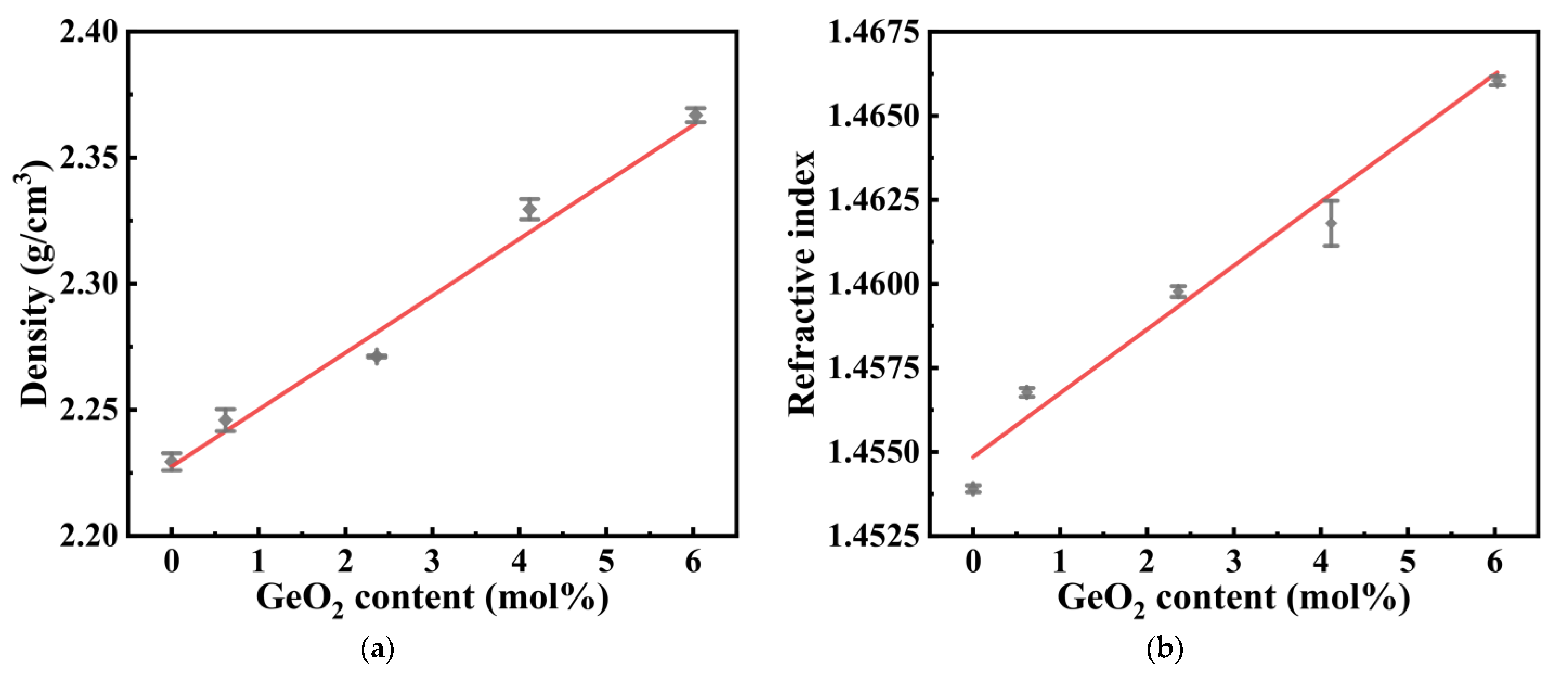
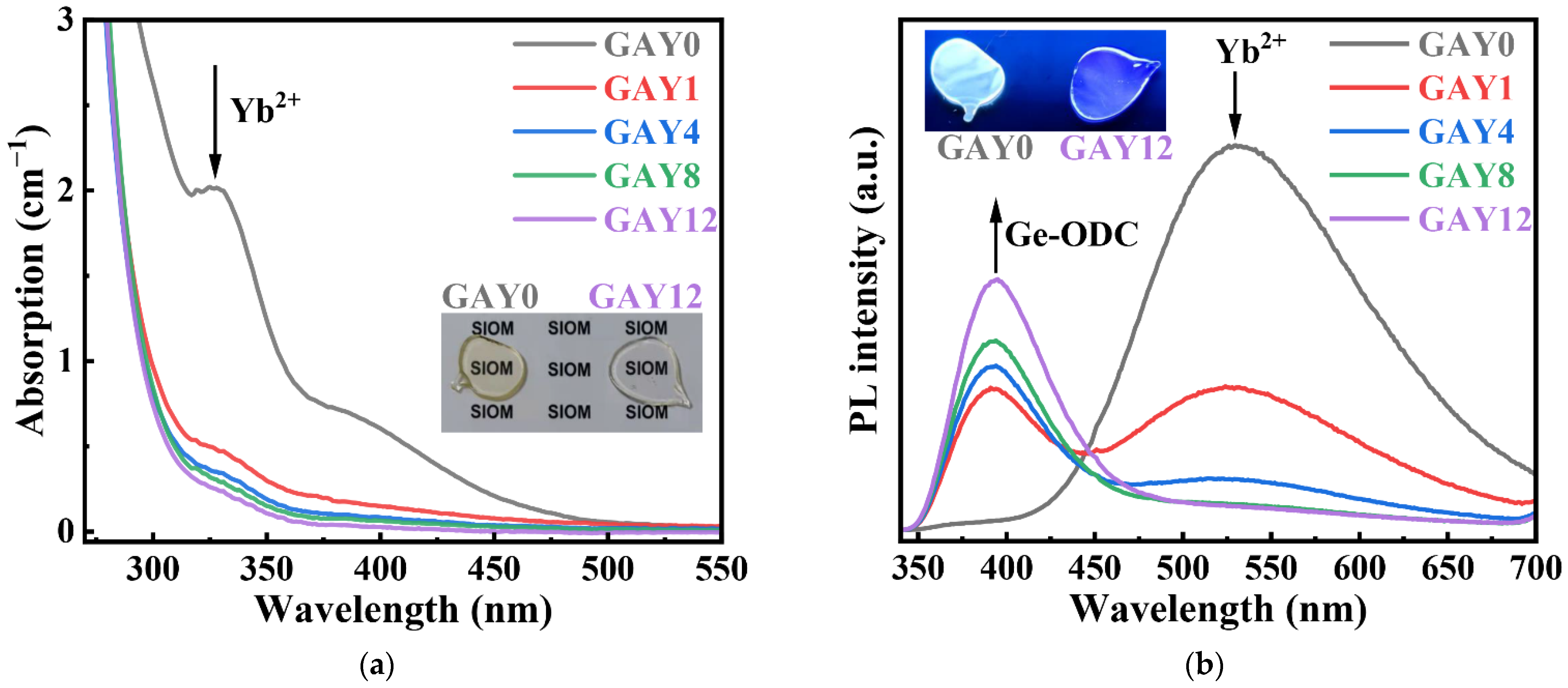
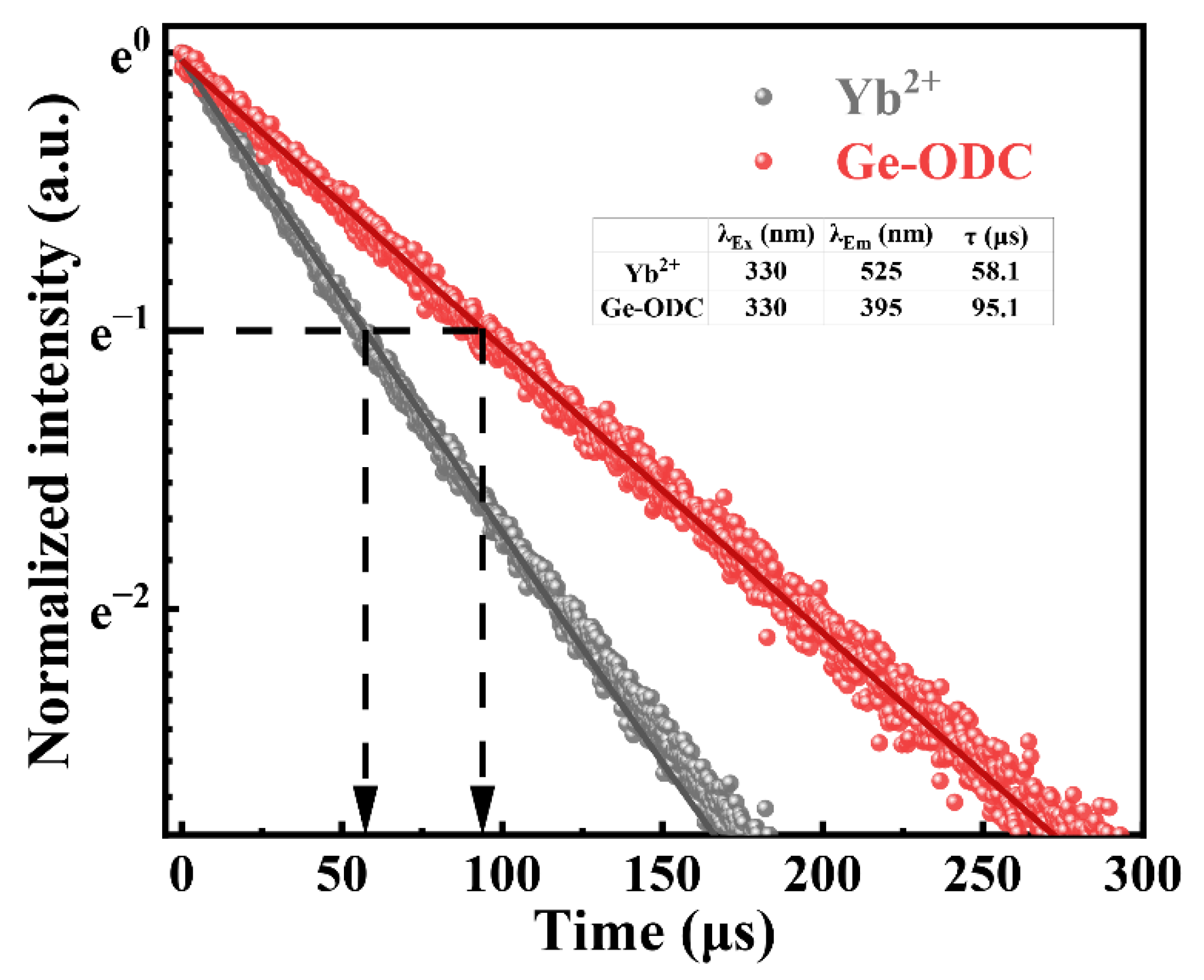
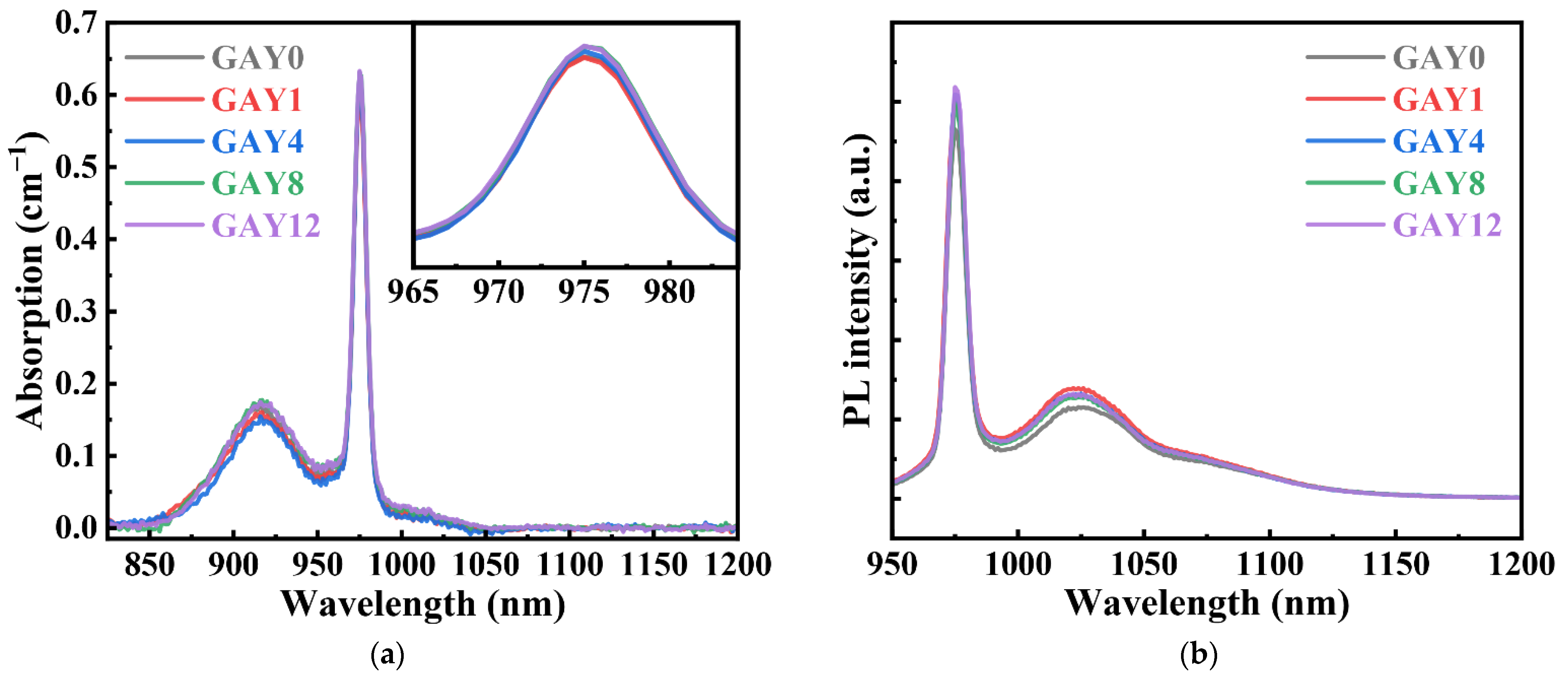
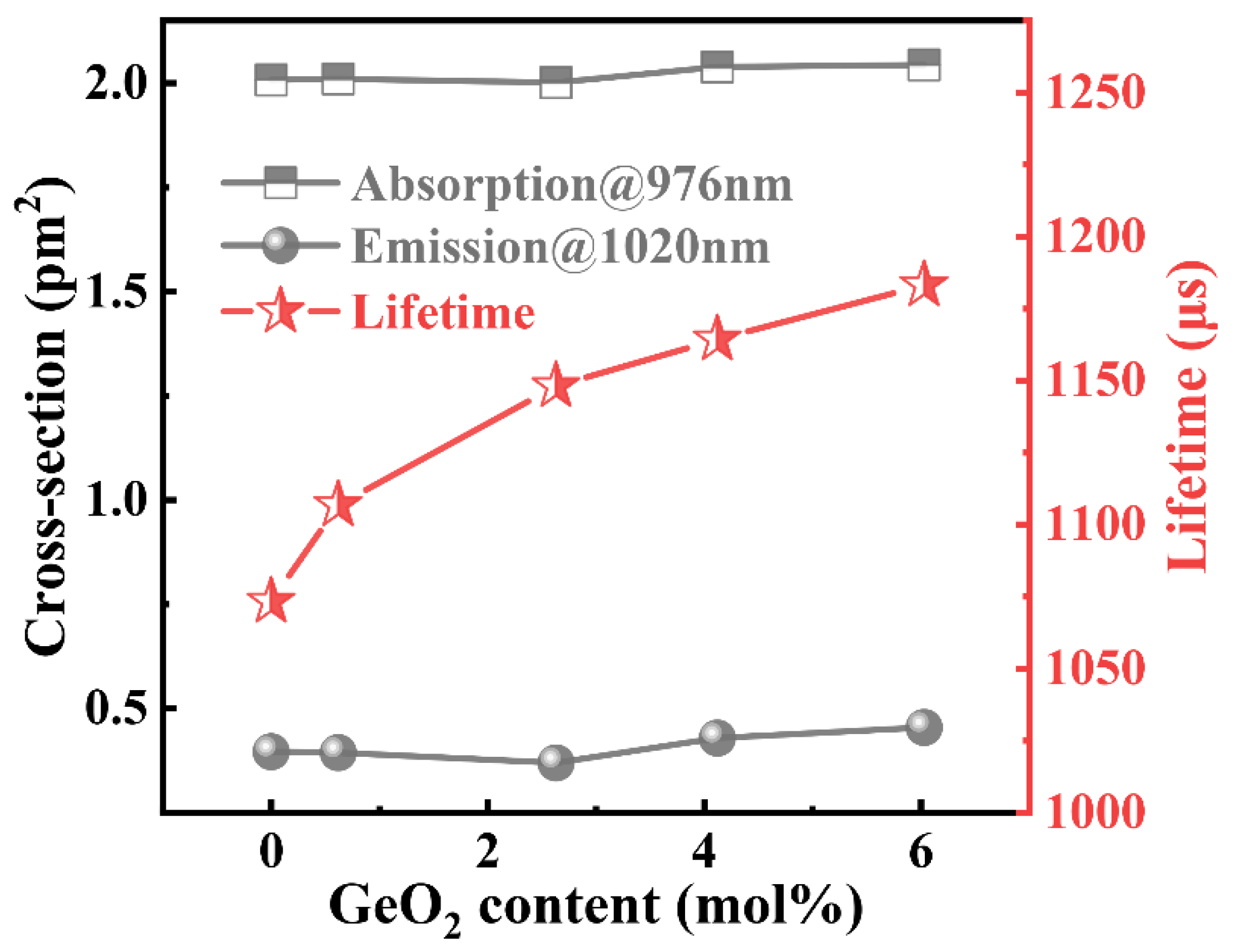
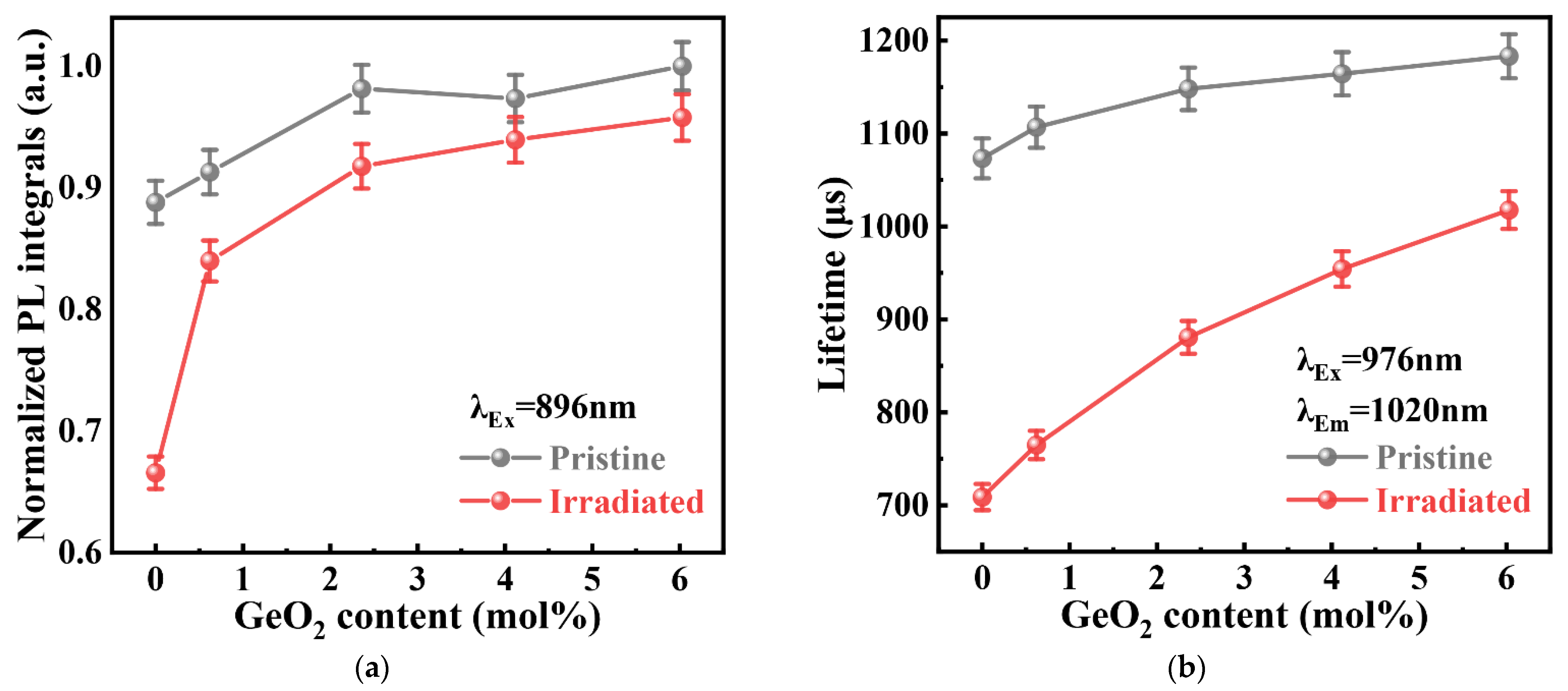
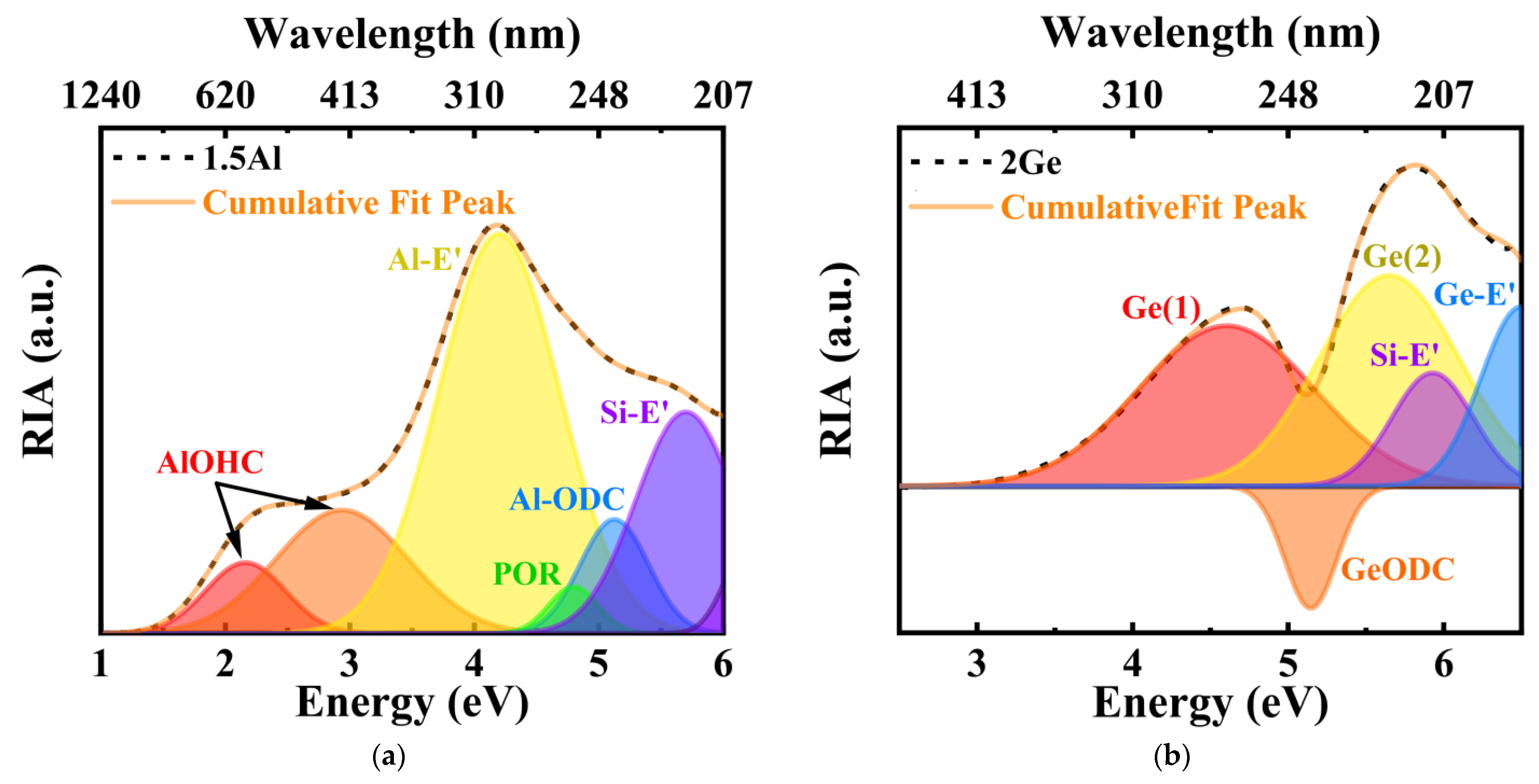
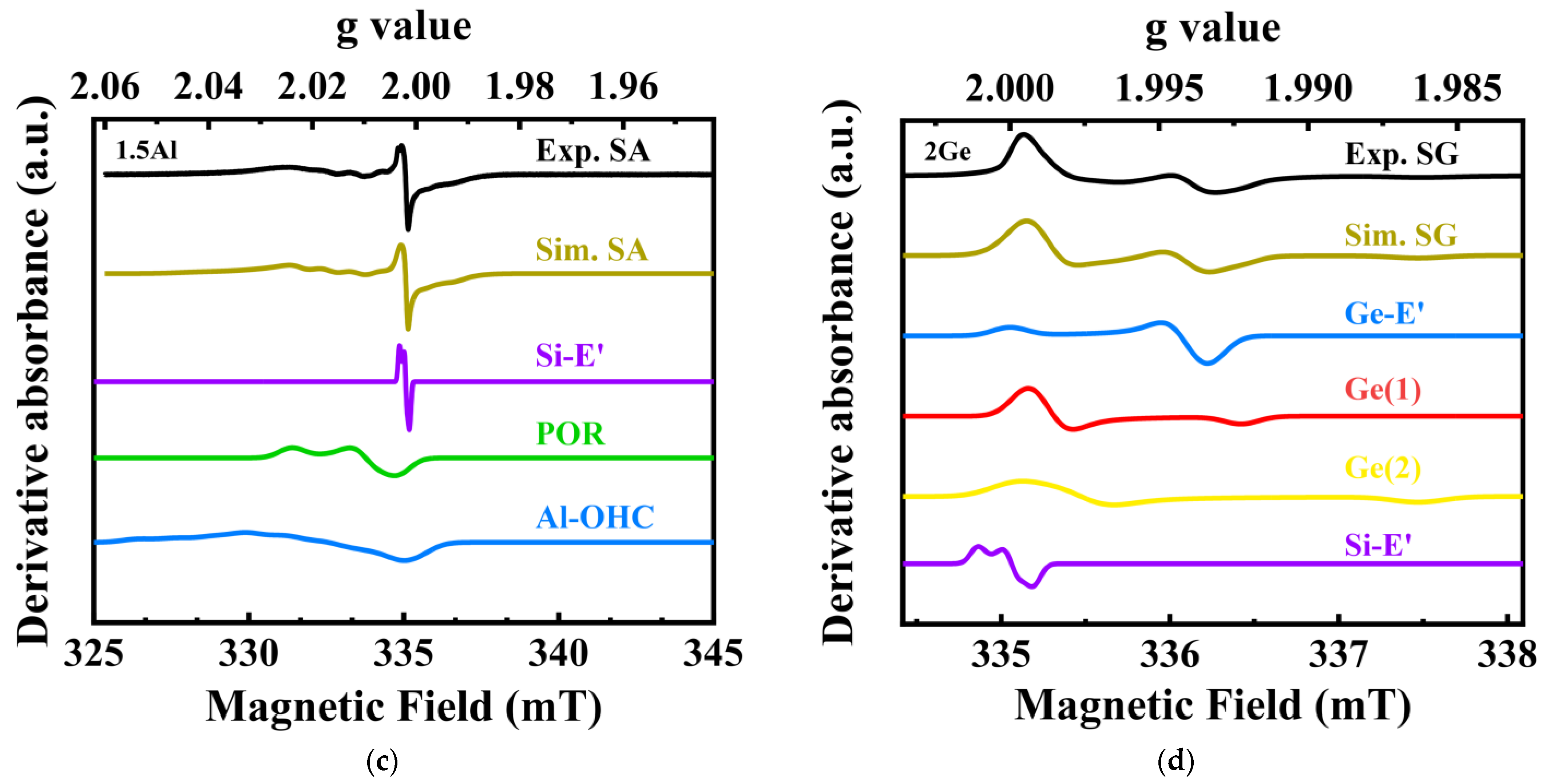

| Samples | Theoretical Composition (in mol%) | Actual Composition (in mol%) | ||||
|---|---|---|---|---|---|---|
| GeO2 | Yb2O3 | Al2O3 | GeO2 | Yb2O3 | Al2O3 | |
| 1.5Al | 0 | 0 | 1.5 | 0 | 0 | 2.11 |
| 2Ge | 2 | 0 | 0 | 1.17 | 0 | 0 |
| GAY0 | 0 | 0.15 | 1.5 | 0 | 0.16 | 2.01 |
| GAY1 | 1 | 0.15 | 1.5 | 0.62 | 0.16 | 2.45 |
| GAY4 | 4 | 0.15 | 1.5 | 2.36 | 0.16 | 2.10 |
| GAY8 | 8 | 0.15 | 1.5 | 4.12 | 0.15 | 2.21 |
| GAY12 | 12 | 0.15 | 1.5 | 6.03 | 0.16 | 2.33 |
Publisher’s Note: MDPI stays neutral with regard to jurisdictional claims in published maps and institutional affiliations. |
© 2022 by the authors. Licensee MDPI, Basel, Switzerland. This article is an open access article distributed under the terms and conditions of the Creative Commons Attribution (CC BY) license (https://creativecommons.org/licenses/by/4.0/).
Share and Cite
Zhu, Y.; Jiao, Y.; Cheng, Y.; Shao, C.; Yu, C.; Dai, Y.; Hu, L. Influence of GeO2 Content on the Spectral and Radiation-Resistant Properties of Yb/Al/Ge Co-Doped Silica Fiber Core Glasses. Materials 2022, 15, 2235. https://doi.org/10.3390/ma15062235
Zhu Y, Jiao Y, Cheng Y, Shao C, Yu C, Dai Y, Hu L. Influence of GeO2 Content on the Spectral and Radiation-Resistant Properties of Yb/Al/Ge Co-Doped Silica Fiber Core Glasses. Materials. 2022; 15(6):2235. https://doi.org/10.3390/ma15062235
Chicago/Turabian StyleZhu, Yiming, Yan Jiao, Yue Cheng, Chongyun Shao, Chunlei Yu, Ye Dai, and Lili Hu. 2022. "Influence of GeO2 Content on the Spectral and Radiation-Resistant Properties of Yb/Al/Ge Co-Doped Silica Fiber Core Glasses" Materials 15, no. 6: 2235. https://doi.org/10.3390/ma15062235
APA StyleZhu, Y., Jiao, Y., Cheng, Y., Shao, C., Yu, C., Dai, Y., & Hu, L. (2022). Influence of GeO2 Content on the Spectral and Radiation-Resistant Properties of Yb/Al/Ge Co-Doped Silica Fiber Core Glasses. Materials, 15(6), 2235. https://doi.org/10.3390/ma15062235







